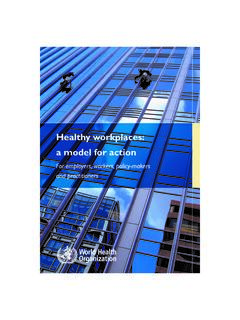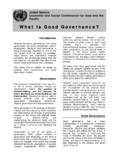Transcription of Prison Incident Management Handbook
1 Prison Incident Management HandbookStrengthening a country s capacity to develop, maintain and manage a viable, safe, secure and humane Prison system is an integral part of sustainable, nationally-owned peace-building efforts and an important building block for preventing relapse into conflict. This Prison Incident Management Handbook is intended to provide guidance to united nations corrections officers and other partners that assist national Prison authorities in addressing the many Prison security challenges. It provides a framework to maintain good order in prisons and exercise safe and humane control of prisoners. UN 2013 All rights reservedCover images: UN PhotoDesign and layout: Rick Jones Incident Management Handbook2 Prison Incident Management Handbook Forewordstrengthening a country s capacity to develop, maintain and manage a viable, safe, secure and humane Prison system is an integral part of sustainable, nationally-owned peace-building efforts and an important building block for preventing relapse into conflict.
2 Prison authorities are often overwhelmed with challenges and, in an already fragile environment, the capacity of national authorities to prevent or effectively man-age Prison security incidents, such as mass escapes or riots, can significantly impact peace and nations corrections personnel deployed by the department of Field support (dFs) and the department of Peacekeeping operations (dPko) assist host countries to address Prison security gaps, overcrowding, infrastructure needs, and the water, food, health and sanitation requirements of prisoners. they also train national Prison personnel and assist the authorities in the development and implementation of Prison -related policies and procedures. to support the activities of united nations personnel in the field, the criminal Law and Judicial advisory service of the dPko office of rule of Law and security institutions has developed a growing body of operational policies, guidance materials and lessons learned studies.
3 This Prison Incident Management Handbook , endorsed by dPko and dFs, is intended to provide guidance to united nations corrections officers and other partners that assist national Prison authorities in addressing the many Prison security challenges. it provides a framework to maintain good order in prisons and exercise safe and humane control of publication of this Handbook comes at a time when dPko and the united nations development Programme have jointly assumed the responsibility of a global Focal Point for the police, justice and corrections areas in the rule of law in post-conflict and other crisis situations. this new arrangement presents a unique and exciting oppor-tunity for the united nations to enhance the predictability, coherence, accountability and effectiveness of its assistance efforts in these wish to express our deepest appreciation to all united nations departments, agen-cies, funds and programmes who contributed to the development of this Handbook .
4 ForeWord 3in particular, we would like to recognize the contributions of united nations correc-tions officers in the field for their perspectives, insights and shared experiences that shaped this Handbook into a practical and user-friendly guide on managing Prison security incidents. Herv Ladsous Ameerah HaqUnited nations Under-secretary-general united nations Under-secretary-generalfor Peacekeeping operations for Field supportPrison Incident Management Handbook4 acknowledgementsthe Prison Incident Management Handbook was developed through a collaborative effort of a wide range of actors from within the united nations , corrections experts, academics and policy-makers. the criminal Law and Judicial advisory service (cLJas) of the office of rule and Law and security institutions (oroLsi) in the department of Peacekeeping operations (dPko) would like to thank the numerous united nations agencies, departments, funds and programmes at within the united nations , who con-tributed to the development of this Handbook .
5 Donorthis Handbook would not have been possible without the generous funding provided by the government of canada. We are grateful for canada s continued support to rule of law in peacekeeping thank Mr. drury allen, who over a period of two years worked closely with cLJas and its key partners through an ongoing consultative process in the development of this Handbook . Contributorsthe bulk of the development of this Handbook was undertaken by united nations dPko staff. We recognize the valuable contributions from the corrections components of dPko Missions, in particular binUca, MinUstaH, MonUsco, UnaMa, UnaMid, UnMit, UnMiL, UnMiss, and Unoci. We also want to thank the various oroLsi components who engaged in the process from gathering information to editing the final draft. ReviewersFinally, we appreciate all our partners who contributed their perspectives, ideas and comments.
6 While all contributions were taken into consideration, the final product does not necessarily reflect all inputs for reasons of limitations to the specific technical theme on managing Prison incidents and the related purpose of the Handbook . thanks to icrc, oHcHr, UndP, Unodc, and Penal reform international. contents 5 contentsIntroduction .. 7 Key Concepts .. 10 Chapter 1 Principles of Prison Security: Good Order and Control .. 11 Chapter 2 Maintaining Good Order .. 15a. operational frameworks 15b. accountability 16c. operational capacity and competence 19staff capacity 19staff competence 19d. elements of dynamic security 21 Prisoner classification 23 Prisoner supervision and movement control 24searching 28staff patrols 31e. contingency planning 32scenarios, simulations and table-top exercises 35 Chapter 3 Maintaining Control.
7 47a. static security 47 Perimeter security 47 Prisoner accommodation 51 Prisoner exercise areas 516 Prison Incident Management HandbookVisiting areas 52other Prison buildings 52key control 53armoury 54b. Incident Management 551. respond 552. isolate and contain 563. report and record 564. identify response resources 575. Manage the Incident 576. resume normal Prison routines 587. review actions 58c. Use of force 59 Use of force continuum 60 Use of force in a problem-solving context 64authority for the use of force 65 Managing vulnerable prisoners 65 Annex 1 Common Causes of Major Disturbances, Riots and Mass Escapes .. 71 Annex 2 Lessons Learned and Recommendations from Mission Visits .. 76 Bibliography .. 98 introdUction7 introduction this Handbook has been prepared to assist corrections advisors on assignment with united nations peacekeeping operations to advise national Prison Management on Prison security and Incident Management .
8 It includes principles, conceptual frameworks and suggestions to help mitigate and prevent mass escapes and Prison disturbances in mission settings. the Handbook provides suggested courses of action for corrections advisors and should guide discussions with Prison Management related to good order and control in the Management of Prison is based on extensive lessons learned from field missions in south sudan, Liberia, the democratic republic of the congo (drc) and Haiti. suggestions and knowledge gained from advisors in the field are highlighted in italics throughout the Handbook . in addi-tion, annex 3 provides recommendations and suggested courses of action to address issues identified and raised during mission visits, based on observations by experienced corrections Handbook was developed to address critical Prison security challenges in post-conflict countries.
9 A number of major Prison disturbances or mass escapes have occurred in united nations missions, some involving loss of life or serious injuries to prisoners, staff or members of the public. these incidents call into question the ability of a Prison service to maintain good order and exercise control over prisoners, and the ability of the united nations to support host countries and national authorities in their capacity to respond to security extent to which prisoners feel that they are treated as human beings, are kept informed, and know their rights, obligations and responsibilities affects the overall culture and climate of a Prison . it also determines, to a large extent, the type of Incident that causes of frequent Prison disturbances and escapes include: blockages in the crim-inal justice system that give rise to prolonged pre-trial detention without any expecta-tion of a future court appearance; overcrowding; gaps in organizational structure; not enough or poorly trained Prison staff; poor conditions for Prison staff; inadequate equip-ment for Prison Management ; weak physical Prison infrastructure; non-classification of prisoners; little information on prisoners; lack of contact with the outside world (faith and family) by prisoners; ideological or political protests; gangs; unresolved pris-oner grievances.
10 And repressive punishment Incident Management Handbookin many post-conflict countries, Prison staff members are poorly paid, have had little or no Prison training, and have minimal supervision; therefore, they may be suscep-tible to corruption. if the conditions of Prison staff are not addressed, then all other security measures become staff members need to be present, attentive and vigilant. they must conduct a range of regular security functions and demonstrate to prisoners that they know what is going on and can maintain the good order of the measures need to be put in place to separate and protect women, juveniles and other vulnerable Prison populations. they can be the target of abuse and may be particularly at risk in Prison united nations department of Peacekeeping operations (dPko) approach to sup-porting Prison systems is underpinned by international norms and standards, including the Universal Declaration of Human Rights (1948)1 and the Standard Minimum rules for the Treatment of Prisoners (1955).
















